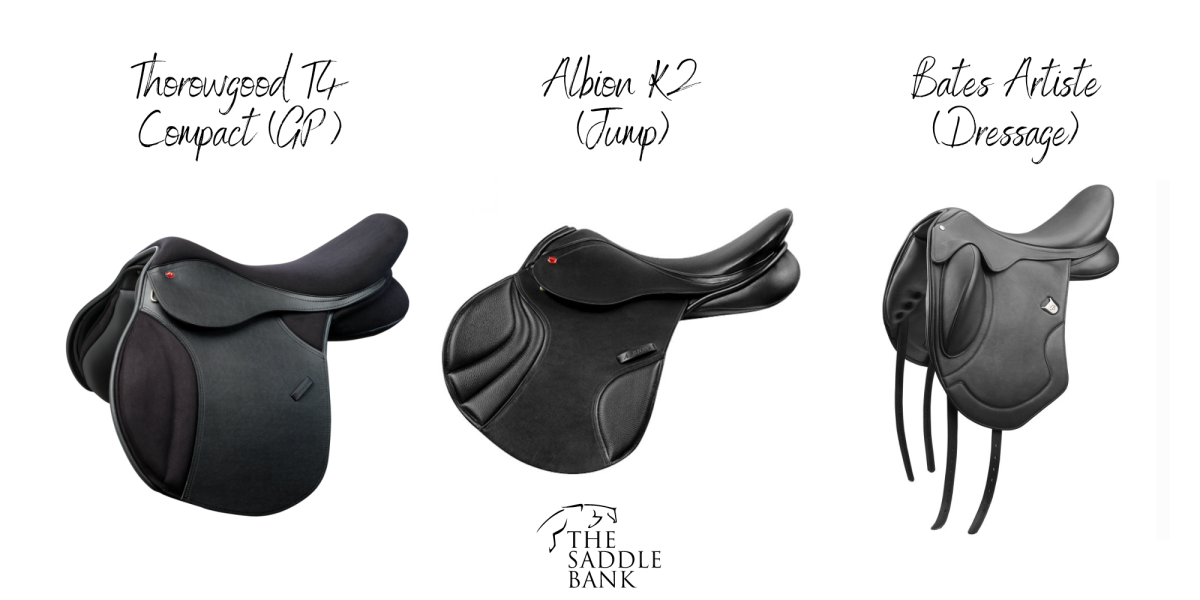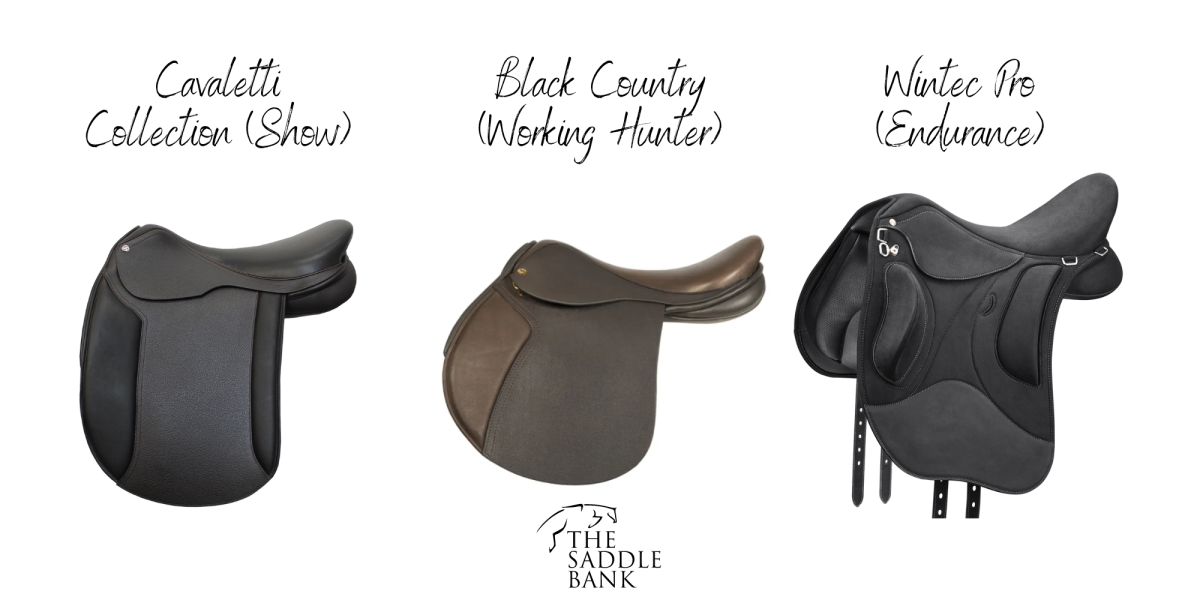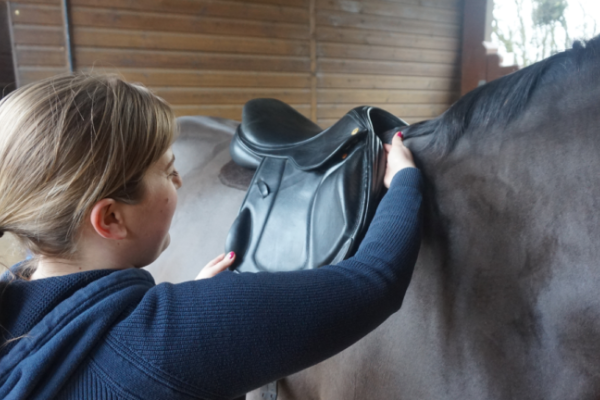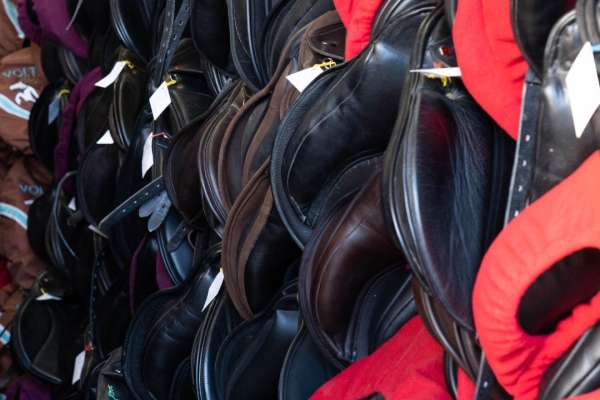The different types of saddles
A saddle distributes the weight of a rider correctly over a horses back. This gives the rider a centre of gravity which then becomes one with the horse. Did you know? Having a human feels three times heavier on the horses back without a saddle than with a saddle. Dependent on where abouts you live, would depend on what saddle is most common. Today we are talking about the different types of English, Western and Australian saddles. Saddles aren’t always needed. Sometimes it is good to ride bareback to improve core strength, but this isn’t something to do for long periods of time. It is a good idea to ride without stirrups sometimes too, it really helps improve your position (you can thank us later).
If you are still a bit confused about which saddle or any saddle related product is best for you why not get in touch with our friendly customer support team via phone on +44 (0) 1733 301 488 or email info@thesaddlebank.com.
Our lovely team are always happy to help as much as they can and provide you with the information you need to make the best decision for you and your horse.
English Saddles
We’ll start with the best. Well, we are slightly bias, but British is best, right? There are more than 7 different types of English saddles, and we'll be covering the main ones.
General Purpose or VSD Saddles
The famous ‘G.P’ Saddle or VSD Saddle. The term VSD originates from Germany and stands for ‘Very Slightly Dressage’. Where the rider can change discipline by changing the stirrup length. For example, if you were participating in flat work then you would have your stirrups longer than if you were jumping. These saddles are suitable for the lower levels of equestrian sport. Or perhaps someone that enjoys a bit of everything. Why stick to one when you can do everything? Gaining knowledge in every discipline expands your knowledge as a rider and horse man or woman. These saddles are used in the riding school. The General-Purpose saddle is for someone who is more inclined to do a bit of jumping. The VSD saddle is a more versatile dressage saddle, this saddle lies in-between dressage and general-purpose saddle.
The Dressage Saddle
For our dancing friends out there. This close contact saddle has a deep seat with a high pommel and cantle. Their flaps are long and straight, this is to ensure your legs are close to the horse to direct each specific movement. Their knee rolls are large and long to support the long, lower leg.
The Jumping Saddle
For the adrenaline junkies out there, time to fly. A jumping saddle has a flat seat. Their knee pads can be adjusted to suit the preference of the rider. They also can come with a thigh block. These locks aids support in the air and on landing. Their flaps are forward and rounded to give support to the shorter leg used in jumping.

The Side Saddle
Something a little different. The side saddle is a 2 pommel design which is used so a woman can ride with both legs on one side of the horse. The right leg goes on top of the pommel, while the left leg goes in a normal position. Fun fact, you do not actually ride ‘sideways’. This saddle gives excellent security for galloping and jumping. Although, to be honest we are going to stick to the ‘normal’ way.
The Racing Saddle
The main thing about the racing saddle, is the weight. The race jockeys have strict weight limit they must adhere to. The jockeys firstly get weighed without their tack, and then with their tack. These saddles have no features to them, they have a small, long, and flat seat. These saddles are not designed to be “ridden in” as such. Jockeys race in a forward seat. The saddle is made from lightweight leather.
The Show Saddle
The Show Saddle is a saddle with a high amount of detail. It is designed for you to stand out from the crowd. The disadvantage to this saddle is it has very little support for the rider with no knee or thigh rolls. However, they are brilliant in the show ring. They offer a close fit and straight-cut flap and are specifically designed to show off the horses conformation. They are generally slim lined and straight cut.
A Working Hunter Saddle
The Working Hunter Saddle is a relatively new design. The saddle is straight cut to help accentuate the horses shoulder. However, they offer slightly more support than the show saddle as they have knee rolls. The reason for the differences between this and the show saddle is because the working hunter discipline involves jumping. It has a low cantle which provides a flatter seat. The riders in working hunter tend to ride in a light seat. They are marked on style and performance. Therefore, the saddle is very important in providing security but also showing off the horses conformation.
The Hunting Saddle
The Hunting Saddle is made to be sat in for long periods of time. The seat is large providing comfort for the rider. The saddle tends to be wider to fir horses with a wider shoulder. The seat is very flat. This saddle has the security to be able to jump big fences too. Picture how you would position yourself when you jump a large hedge with a mighty large ditch on the other side. The hunting saddle is shaped to aim to push the riders weight back in the saddle and their feet forwards, this is so the rider can brace themselves and sit back when jumping large obstacles. The saddle which excites us the most for this discipline is the Wintec 500 which is a synthetic saddle that can be hosed off after your days hunting.
The Event Saddle
The Event Saddle has similarities to the jumping saddle, however, is designed more for cross country riding. It is a forward cut jumping saddle with a flatter seat, which allows the rider to be in a light seat allowing maximum movement from the horse. The saddle has a lot of support for added security, allowing the rider to shift balance easily. They are also more forward cut than the show jumping saddle.
The Endurance Saddle
The Endurance Saddle has a broad and padded seat. The importance of this saddle is the comfort. This saddle is designed to be sat in for long periods of time. These saddles tends to have a short panel design which allows to fit short-backed arab-typed horses. The flap is straight cut, which allows for longer and relaxed endurance leg position. The seat sometimes has an additional gel feature, which prevents aching muscles the day after!
Due to new technology, most of these saddles are adjustable. They also come in different types of leather, pure leather or synthetic materials. The prices range in these saddles. However, the saddles which are specifically created for certain disciplines tend to be higher in price.

The Western Saddle
Onto the Western Cowboys now. There are 10 types of Western Saddles. They are far heavier than any English type of saddle. They are designed for comfort and a flatter seat. These intricately decorated saddles are made from brown leather. There is a horn at the front which can be grabbed onto by the rider. These saddles are specifically designed dependent on what these guys get up to. For example, cutting, reining, barrel racing, ranch, trail, and pleasure all have different features. The western saddle is a heavy piece of equipment designed for riders’ comfort and mainly used on ranches. The contoured cantle, the fenders and stirrups keep the rider secure and comfortable. English saddles offer a closer contact than the Western.
The Stock Saddle
Finally, to the Aussies. The stock saddle is an Australian saddle which has been invented since 1979. They evolved from English (cavalry) saddles. It has features of a Western Saddle and can be described simply as “big dressage saddle”. The English saddle has a close contact seat. The Western saddle has a rear seat. The Stock Saddle is a seat in-between both these saddles. They are used for long, endurance rides. It has been said that there is no saddle more comfortable.
A stock saddle seat is mainly used for ranchers but is also used at rodeos. The saddle can weigh as much as 40 pounds. Unlike western saddles stock saddles don’t have horns. There are variations within this type but overall they are designed for comfort and stability or making a sudden change in direction. Something to be aware of though, the ‘ears’ on a stock saddle can prevent the rider from rising to the trot.
The Stock and Western Saddles are an ideal type of saddle for the beginner or novice riders, due to the wide range of support they give to the rider.
There are also what is known as ‘half breeds’ saddles. These are a combination of a Western and a Stock saddle. They are increasing in popularity with riders having the comfort of a Western Saddle but are hornless like a Stock saddle. They do not have padded panels on the underside.
Here at The Saddle Bank we offer a wide range of different types of saddles, suited for majority of disciplines. We even offer stock saddles too. So, whatever you are looking for, contact our friendly team and we will be able to help!
For all our saddles which we have for sale, check out this link.
The Saddle Bank offer 5 Day Trials on all Quality Used saddles to UK Mainland customers. Therefore, you can try the saddle before committing to keeping it.
Full details on our trial policy can be found here.
Are you from outside of the UK? No problem. The Saddle Bank offers international shipping.
Just email us for a quote info@thesaddlebank.com
Learn more about how saddles should fit….
If you are a horse owner or rider and would like to learn more about saddle fitting. As well as how the saddle can impact your horses performance and welfare, check out our Recognising Saddle Fit Issues Course!












